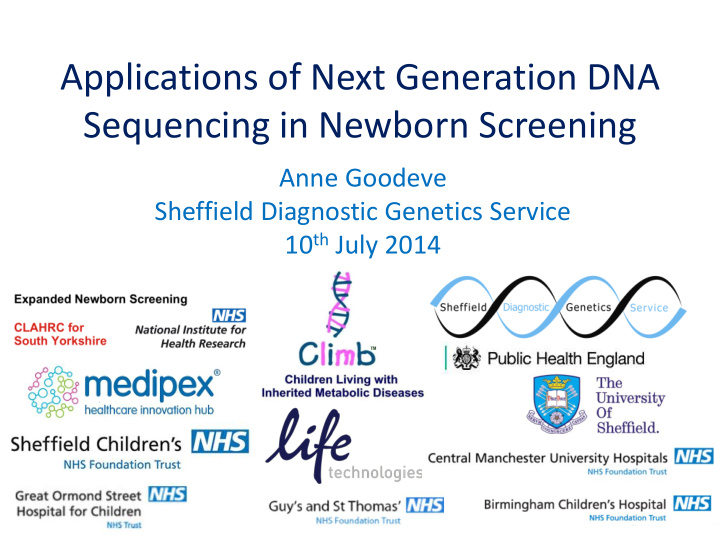



Applications of Next Generation DNA Sequencing in Newborn Screening Anne Goodeve Sheffield Diagnostic Genetics Service 10 th July 2014
Outline Why undertake genetic analysis? Sanger sequencing Next generation sequencing NGS for NBS project plan
Why undertake genetic analysis? Definitive disease diagnosis/exclusion Prognosis and management Determine inheritance and disease risk in family members
Why undertake genetic analysis? Autosomal dominant? Autosomal recessive? X-linked recessive?
Genetic analysis Gene of interest 0 20 40 60 80 100 120 140 160 180 kb 1 2 - 4 5 6 7-9 10 - 13 14 15-22 23-25 26 25 26 exons and flanking introns ~25bp Examine sequence for point mutations Examine sequence for large deletions & duplications
Current Sanger DNA sequencing workflow Blood sample Genomic DNA PCR amplification DNA sequence Data analysis Provides information on point mutations
Sanger DNA sequencing Exon 1 Exon 2 Exon 3 Exon 4 PCR amplification DNA sequencing
Sanger DNA sequencing
Sanger DNA sequencing Follow by bioinformatic analysis to determine which sequence variants may be disease associated
Changes in DNA sequencing technology Sanger sequencing ~3x10 4 bases Next generation sequencing ~3x10 9 bases
Next generation DNA sequencing Massively parallel DNA sequencing Many patients samples can be analysed together Whole exome/genome analysis possible using larger capacity instruments
Workflows Sanger Next generation sequencing sequencing Genomic DNA Sheared Sheared long Tiled small genomic Genomic DNA range PCR amplicons DNA PCR amplification Clonal amplification Sequence Sequence Analysis Analysis
Sequencing from sheared genomic DNA Gene A Gene B Gene C Sheared genomic DNA for genes of interest selected by probe hybridisation Hybridisation probes Genes of interest selected by hybridisation
Sequencing from sheared genomic DNA Indexing DNA enables association of results with correct patient Indexed & selected sheared genomic DNA Patient 1 Patient 2 Patient 3
Sequencing from sheared genomic DNA A B C Aligned sequencing data Patient 1 Patient 2 Sequence variant Patient 3
Sequencing from sheared genomic DNA Sequence coverage of exons for gene of interest Diagnostic standard sequence coverage 30 x / nucleotide Alamut v2.2 Interactive Biosoftware
Sequence output format Variant type Gene (with HGVS) 1st check Comments splicing (NM_000135:exon9:c.710-12A>G,NM_001286167:exon9:c.710-12A>G, SNP on Poly List NM_001018112:exon9:c.710-12A>G) splicing (NM_000135:exon12:c.894-8A>G,NM_001286167:exon12:c.894-8A>G) SNP on Poly List splicing (NM_000135:exon15:c.1226-2A>G,NM_001286167:exon15:c.1226-2A>G) #:# splicing (NM_000135:exon22:c.1900+24A>T,NM_001286167:exon22:c.1900+24A>T) Novel SNP placed on poly List splicing (NM_000135:exon33:c.3067-23G>A,NM_001286167:exon33:c.3067-23G>A) SNP on Poly List splicing (NM_000135:exon33:c.3067-4T>C,NM_001286167:exon33:c.3067-4T>C) SNP on Poly List nonsynonymous SNV :NM_000135:exon33:c.3263C>T:p.S1088F,:NM_001286167:exon33: SNP on Poly List c.3263C>T:p.S1088F splicing (NM_000135:exon34:c.3348+18A>G,NM_001286167:exon34:c.3348+18A>G) SNP on Poly List synonymous SNV :NM_000135:exon37:c.3654A>G:p.P1218P,:NM_001286167:exon37: SNP on Poly List c.3654A>G:p.P1218P synonymous SNV :NM_000135:exon38:c.3807G>C:p.L1269L,:NM_001286167:exon38: SNP on Poly List c.3807G>C:p.L1269L nonsynonymous SNV :NM_000135:exon40:c.3982A>G:p.T1328A,:NM_001286167:exon40: SNP on Poly List c.3982A>G:p.T1328A All sequence variants identified listed Manual check required to determine which if any may be pathogenic
Variant filtering workflow Variants from sequencing 500 variants Variants within 265 variants genes of interest Remove frequent 20 variants polymorphisms Assess pathogenicity 4 variants Candidate 2 variants mutation(s)
Large deletion detected by NGS Read depth; patient / mean of 7 controls Heterozygous for ex 12_31del Exon No.
Next generation sequencers Life Technologies Illumina Roche Oxford Nanopore Ion PGM MiSeq GS Junior MinION 200-400 bp reads 2x 250 bp reads 400 bp reads Average read 5.4 kb 40 Mb to 1.5 Gb 8.5 Gb 28 Mb Released 2014 8 hours 35 hours 10 hours In beta testing Ion Proton GS Flex Titanium 200 bp reads 700 bp reads Up to 10 Gb 0.7 Gb
Impact of NGS on genetic testing Cost Little impact on single gene disorders Significantly reduced for large genes and for multigene disorders Turnaround times Initially most services 8 - 12 weeks for all genes Potential for significant reduction
Newborn screening in the UK 5 current disorders; Phenylketonuria (PKU) Congenital hypothyroidism (CHT) Sickle cell disease (SCD) Cystic fibrosis (CF) Medium chain acyl co-A dehydrogenase deficiency (MCADD)
Five pilot NBS disorders Maple syrup urine disease (MSUD) Homocystinuria (pyridoxine unresponsive) (HCU) Isovaleric acidaemia (IVA) Glutaric aciduria type 1 (GA1) Long-chain hydroxyl acyl-CoA dehydrogenase deficiency (LCHADD)
Health Innovations Challenge Fund aims Provide novel diagnostic tests or procedures Permit timely diagnosis of conditions where no test currently exists Offer solutions that can be readily integrated into and deployed widely across UK healthcare systems and beyond
Maple syrup urine disease Day Birth 0 Dried blood spot 5 Result MSUD +ve 7 Clinical intervention
Do no harm Dietary management X ? Very little natural protein Dietary supplements Clinical monitoring & management X X Lifelong intervention
Newborn screening Biochemical analysis Unaffected No. individuals Adjunct genetic testing Screen positive Analyte level DNA sequencing Genetic analysis to Report reduce ambiguity
F508del:F508del F508del:R117H Lungs Pancreas Reproductive tract Shortened life span Genotype:phenotype correlation in Cystic Fibrosis
Aim 1 Expand the utility of adjunct genetic testing Remove ambiguity Enhance understanding of genotype : phenotype correlation For pilot scheme disorders & MCADD
Healthy controls Screen positive Clinically affected Genotype : phenotype database
Aim 2 Next generation DNA sequencing from a dried blood spot For disorders where there is no biochemical marker suitable for newborn screening Day The Challenge 0 Birth Dried blood spot 5 +ve result 7 Clinical intervention
Aim 2 Utilise healthy control individuals’ DNA Compare DNA extracted from venous blood with DNA extracted from dried blood spots Aim to obtain same sequence quality from dried blood spot DNA as from venous blood Use current screened disorders to trial the analysis
Project outcome Genotype : phenotype correlation Ambiguity Performance UK and worldwide programmes Dried blood spots DNA sequence Enhanced sequencing pipeline for other clinical pathways and healthcare systems
The team Ann Dalton Anne Goodeve Director SDGS Research Lead Scientist Genetics, links to NBS Research strategy Steve Hannigan Jim Bonham Mark Sharrard Darren Grafham Diana Johnson CEO Climb National newborn Metabolic Physician Head of Lab Services Clinical Geneticist Patient advocate laboratory screening Metabolic team lead NGS & technical Patient & family lead management management
Recommend
More recommend